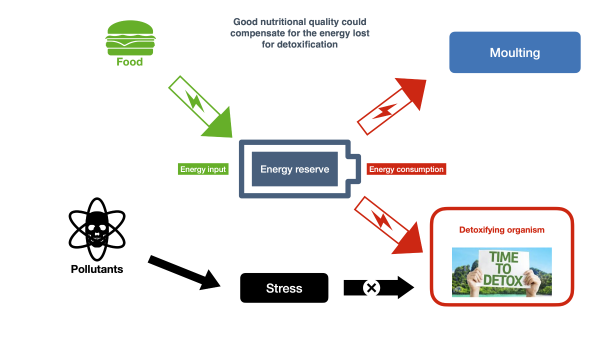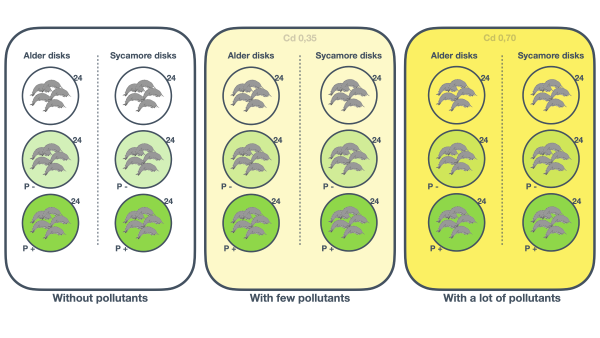Does food quality increases moult organism vulnerability to pollutant impacts? by Charlotte Couedel, Axel Rochaud and Stellia Sebihi
Published by the April 27, 2021 on 9:06 AM
Today's ecotoxicology
For a long time, ecotoxicology focused on the lethal effects of pollutants, with increased individual mortality translating into smaller population size or population extinction. There has been a shift from the study of lethal doses to the impact of smaller doses on more specific processes such as physiology and behaviour (Rand and Petrocelli, 1985; Døving, 1991). The article deals with the effect of pollutants on moulting.
Possible use of ecotoxicology (the case of the article)
Pollutants are an environmental factor causing stress in individuals. Lack of resources is another factor. For this reason, the study attempts to demonstrate and quantify the impact of food quality on the resistance to pollutants of moulting organisms.
Hypotheses of the effect of the diet on the assimilation and detoxification of pollutants
When a pollutant is assimilated by an organism, the body sets up the detoxification system, but it requires energy. Food allows the assimilation of energy by organisms. Good quality of food makes an individual capable of accumulating the energy necessary to ensure vital functions. An organism with energy from good quality food, should be able to activate an effective detoxification. Thanks to this detoxification, the body should be less impacted by pollutants. The study seeks to demonstrate whether this is true.
The interest of the biological model
Gammaridae are macro-invertebrates that are mainly detritus feeders. They feed on detritus, corpses, living or decaying plants. Moreover, they are at the base of the human food chain as they are often industrially bred as fish food. Gammaridae are used to determine the biological quality of watercourses. They are rather pollution tolerant organisms but are nevertheless affected by pollution. Could the physiological changes noticed in Gammaridae be noticed in humans?

A picture of two Gammaridae
Way to understand the effects
The experiment is designed to evaluate single and combined effects of leaf litter stoichiometric quality and Cd exposure on G. fossarum survival and growth. Phosphorus (P) is used as the nutrient in leaf litter. Cadmium (Cd) is used as the pollutant. Phosphorus (P) is a nutrient naturally present in the Gammaridae's food, in this case, leaf litter. Also, industrial activities are often sources of cadmium released into aquatic environments. The main route of exposure to cadmium (Cd) is through the ingestion of contaminated water and food, so Gammaridae is particularly exposed to this type of pollutant.
144 microcosms were performed for each of the 3 levels of Cd concentrations (0 ; 0.35 ; 0.7). For each group, 72 microcosms were realised with Sycamore discs and 72 with Alder discs. It allows to observe the effect in different conditions. Then, among these 72 microcosms, three batches of 24 have been realized. The first batch is a control batch where the composition of the litter was not modified. The second batch was a P- batch, where the litter was deficient in phosphorus and therefore in nutritional value (and which does not allow individuals to extract a lot of energy). Finally, the third lot was P+, it was enriched in phosphorus, the nutritional value is very good.
Several metrics were measured to validate the initial hypotheses. The metrics were chosen for their relevance to evaluate organisms sensitivity to resources quality (leaf species and P content) and pollutant (Cd concentration in water): Cd bioaccumulation and survival rate. But also for their ecological importance: time-to-death, mass growth, time to moult and feeding rate.
Results to remember
- The Gammaridae's moult frequency and growth is amplified by a nutrient-rich diet (P+).
- A presence of pollutants (cadmium) in the Gammaridae’s life site reduces their growth and raise their probability of death.
- A nutrient-rich diet amplified effects of cadmium.
- If we make the connection: The higher quality of food ressources, the more moulting there is and the greater the effect of cadmium. So moulting makes Gammaridae vulnerable to pollutants.
- Species sensitivity to pollutants might be underestimated in ecosystems facing both nutrient constraint and pollutant.

Schematization of the main results
What to infer from this experiment.
The presence of pollutants in the water causes problems in the survival of Gammaridae. Ecotoxicologists are well aware of the bioaccumulation of pollutants in the food chain. As a result, a predator will be more contaminated by the pollutants than is prey. Indeed, predators will keep in them the majority of the pollutants present in their prey. Thus, humans present in the upper part of the trophic chain will be much more contaminated than the Gammare.
So why discharge pollutants into the water? Let's drink it directly!

This post is licensed under a Creative Commons Attribution-ShareAlike 4.0 International License.







